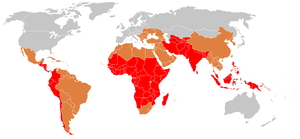Typhoid
- Other unrelated diseases with a similar name are typhus and paratyphoid fever
Typhoid, or typhoid fever, is an illness caused by the bacterium Salmonella enterica subspecies enterica.[1] Symptoms may vary from mild to severe, and usually begin 6 to 30 days after exposure. The disease is spread by water which has the bacteria in it.
Transmission
Typhi is spread through from what is called the fecal–oral route. The source is people who are infected but have no symptoms.[2] An asymptomatic human carrier is an individual who is still excreting typhoid bacteria in their stool a year after the acute stage of the infection.[2]
The disease
Typhoid usually lasts between two weeks and a month. The symptoms of typhoid often appear 10 to 14 days after infection. If no treatment is given, between one and three out of every ten patients die. The rest usually get better after a month, at the most.
Typhoid causes a steady fever of at least 103–104 degrees F (39–40 degrees C). Also, it can cause stomach pains, headache, being delirious (restless, excited, seeing things), and not being hungry. In some cases, flat, pink coloured spots show up on the patient's body. Sometimes there are no symptoms.
Typhoid is not common in countries with good sanitation and clean water. For example, scientists think that there are only 400 cases a year in the United States. In 2015, 12.5 million new cases worldwide were reported.[3] For example, in the Indian subcontinent, typhoid is one of the most common diseases because of poor sanitation and lack of basic hygiene.In that case, typhoid fever is common in children of the one to 15 years age group.
The disease can be treated with antibiotics. There are standard drugs like chloromycetin which cure typhoid.
Typhoid Media
A 1939 conceptual illustration showing various ways that typhoid bacteria can contaminate a water well (center)
Doctor administering a typhoid vaccination at a school in San Augustine County, Texas, 1943
Almroth Edward Wright developed the first effective typhoid vaccine.
References
- ↑ Newton A.E. 2014. Three infectious diseases related to travel. CDC health information for international travel 2014: the yellow book. ISBN 9780199948499
- ↑ 2.0 2.1 Eng SK, Pusparajah P, Ab Mutalib NS, Ser HL, Chan KG, Lee LH (June 2015). "Salmonella:A review on pathogenesis, epidemiology and antibiotic resistance". Frontiers in Life Science. 8 (3): 284–293. doi:10.1080/21553769.2015.1051243.
- ↑ Vos T, Allen C, Arora M, Barber RM, Bhutta ZA, Brown A, et al. (GBD 2015 Disease and Injury Incidence and Prevalence Collaborators) (October 2016). "Global, regional, and national incidence, prevalence, and years lived with disability for 310 diseases and injuries, 1990–2015: a systematic analysis for the Global Burden of Disease Study 2015". Lancet. 388 (10053): 1545–1602. doi:10.1016/S0140-6736(16)31678-6. PMC 5055577. PMID 27733282.
